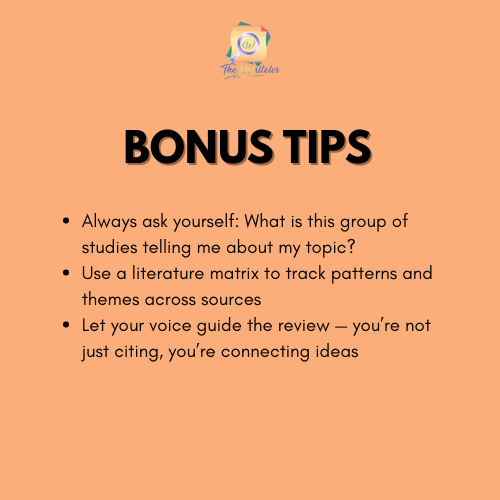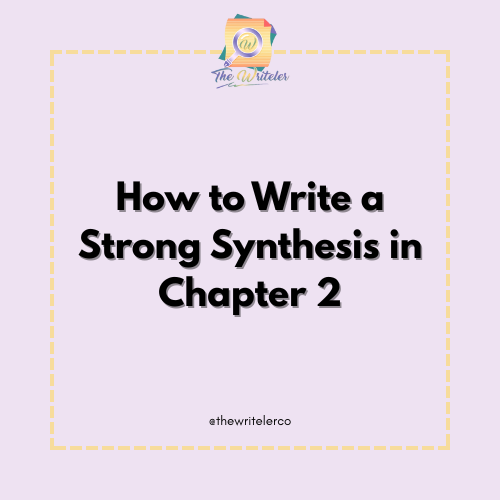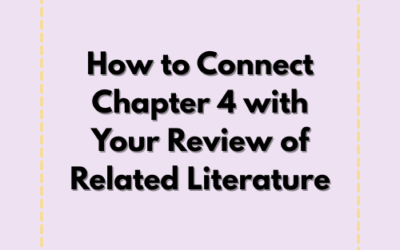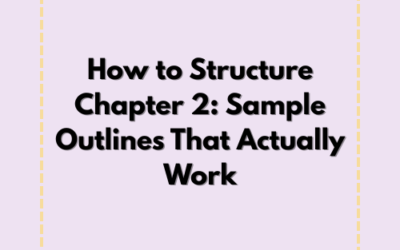Writing Chapter 2 of your thesis or dissertation can be overwhelming — especially when you’ve read dozens of studies and now need to do a synthesis.
You might be thinking:
“I already summarized the studies… isn’t that enough?”
Not quite.
If you want your Chapter 2 to stand out, you need to go beyond summaries and create a synthesis — a cohesive narrative that connects multiple sources, highlights trends and points to the gap your study is trying to fill.
In this guide, we’ll show you exactly how to write a strong synthesis that not only demonstrates your understanding but also justifies your research. Whether you’re a student, a professional, or working on your master’s or Ph.D., this is the key to writing a literature review that works.
What is a Synthesis in Chapter 2?
A synthesis is when you combine and interpret ideas from different sources to create a unified discussion. It shows:
- What researchers agree on
- Where they differ
- What is still unknown
👉 Summarizing says what others said.
👉 Synthesizing shows how those ideas relate to one another — and to your study.
It’s what turns a collection of studies into a meaningful foundation for your research.
Where Should You Place the Synthesis in Chapter 2?
A strong synthesis isn’t just a final paragraph — it should appear in several places:
- ✅ At the end of each theme or section in your literature review
- ✅ At the end of Chapter 2 as a final summary and transition to your framework
- ✅ Even within paragraphs, when discussing multiple studies together
How to Write a Strong Synthesis: Step-by-Step
✅ 1. Group Related Studies
Don’t discuss one study per paragraph. Instead, group studies by theme or variable. This helps you see what scholars are saying about the same concept — and where they differ.
Example grouping:
- Studies on Mindfulness in Education
- Studies on Academic Motivation
- Studies on Mindfulness and Academic Performance
✅ 2. Compare and Contrast Findings
Ask:
- Do the studies agree or contradict each other?
- Are they using the same methods or different ones?
- Are there gaps in population, location, or time?
Then write about those comparisons instead of writing about each study in isolation.
✅ 3. Connect Everything to Your Study
After discussing each group of studies, tie the insights back to your own research.
Use transition phrases like:
- “This suggests that…”
- “These findings align with the variables explored in this study…”
- “However, limited research exists on…”
This reminds the reader that everything you’re saying has a purpose — it builds up to your study.
✅ 4. Identify the Gap
Your synthesis should naturally lead to your research gap — the part that’s still missing, unclear, or underexplored.
Examples:
- “Despite strong evidence linking mindfulness to academic performance, no study has focused specifically on senior high school students in the Philippine context.”
- “Most existing research relies on quantitative methods, highlighting the need for a more in-depth qualitative approach.”
This is where you shine — by clearly positioning your study as the next step in the conversation.
Sample Synthesis Paragraph
Here’s a basic example of what synthesis looks like:
Several studies agree that mindfulness significantly improves student focus and emotional regulation (Santos, 2021; Cruz & Tan, 2022). However, while Santos emphasized its impact on college learners, Cruz and Tan examined elementary students, leaving a gap in understanding how mindfulness affects senior high school students. Moreover, both studies used Western-based instruments, which may not fully reflect the experiences of Filipino learners. This suggests the need for a localized study focused on mindfulness and academic performance in a high school setting.
✅ What makes this strong?
- It groups studies by theme
- It compares their findings and limitations
- It leads directly into a research gap
Helpful Phrases for Synthesis Writing
Use these transitions to show comparison, contrast, and insight:
- “Several studies agree that…”
- “In contrast to earlier findings…”
- “This supports the argument that…”
- “However, none of these studies explore…”
- “Taken together, the literature suggests…”
- “These findings raise important questions about…”
Common Mistakes to Avoid
🚫 Listing studies without linking them
🚫 Using only one source per paragraph
🚫 Forgetting to relate findings to your own research focus
🚫 Skipping the synthesis altogether — leaving readers asking, “So what?”

Remember: Synthesis isn’t extra — it’s the backbone of Chapter 2.
📣 Need Help Writing a Strong Synthesis?
The Writeler Co. is here to support students and professionals who are juggling research with work, life, and business. Whether you’re writing a thesis, capstone, or dissertation for your master’s or Ph.D., we help you efficiently navigate the research journey — from brainstorming to proofreading.
📩 Message us today to get started.
📚 Let’s turn your research idea into a powerful paper.





0 Comments